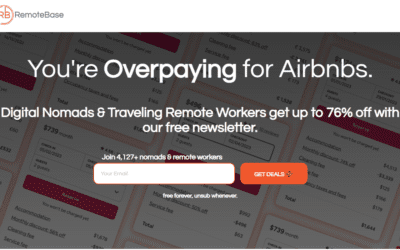|
|
Digital nomads are at the forefront of the work revolution. Many were working remotely long before the pandemic made remote working more accessible. But more than this, many have been at the forefront of being paid for what they accomplish rather than hours worked.
It is still the norm to see work contracts with a list of tasks and responsibilities, but also a prescribed number of hours that need to be worked each week, and often exactly when those hours should be worked and where. Digital nomads have been at the forefront of changing this template.
Not only do digital nomads negotiate on where they work, they often negotiate on when they work. While all know that one digital nomad who has to be glued to his computer from 10 pm to 4 am every day to be online with his team on the other side of the world, this is becoming increasingly uncommon. Increasingly digital nomads are also working when they want as long as they tune in for key meetings and get the work done.
But most contracts still come with an expected number of work hours. While this probably won’t change any time soon, more people are pushing for contracts that give them responsibility for certain areas of work but leave it up to them to determine how to do that, including how much time it takes. Rather than being paid for the time spent, they are being paid for their impact and responsibility.
While this may be a rather extreme example of what an empowered worker looks like, leaders are concerned about how to empower workers to be more productive and innovative and give them more responsibilities and investment in business outcomes.
This is the challenge discussed by a recent briefing from Microsoft WorkLab on how leaders can empower people to control how work gets done. The tech company looks specifically at technological solutions that can empower employees. But underneath all this is the philosophy that it is usually the people who do the job are the ones who know how to do it best, and they should be empowered to do just that.
Read on for a summary of the main findings of the briefing.

Four ways leaders can empower people for how work gets done
According to the briefing, in the ever-evolving landscape of work, the past few years have brought about rapid transformations, reshaping both work and life as we know them. Remote and hybrid work has become the new norm, and organizations are increasingly relying on technology to empower their workforce.
Microsoft recently conducted a survey of 2,700 employees and 1,800 business decision-makers in the United States, the United Kingdom, and Japan to shed light on how leaders can empower their teams and embrace the future of work.
The report resulted in four main insights.
Insight 1 – Empower people to have a say in technology initiatives
Today’s employees hunger for better digital tools, with 87% believing that digital transformation is more important now than ever. However, only 54% of them feel like they have a say in the decision-making process regarding these efforts. This discrepancy highlights a gap between leadership’s perception of priority investments and the actual needs of the workforce.
To bridge this gap, leaders should establish processes that allow teams to advocate for the adoption of new tools and even the retirement of outdated ones. Creating a continuous feedback loop and involving employees from various departments can inspire excellence and ensure that technology initiatives align with the needs of the workforce.

Insight 2 – Use collaborative apps for seamless work
The rise of flexible work arrangements has made collaboration tools essential, with 85% of employees considering them crucial for their organization’s digital transformation. However, 59% of employees feel that the tools they use don’t align with their team’s preferred work methods.
Leaders should consider conducting an audit of their organization’s collaboration tools to identify gaps and areas for improvement. Together with employees, they can develop key performance indicators for the ideal collaboration tool and centralize resources to ensure consistency and integration across the organization. Embedding collaboration capabilities into the workflow can facilitate efficient problem-solving and information sharing.
Read this summary of another recent Microsoft WorkLab research project that uses visualizations to understand how people really collaborate and work together.
Insight 3 – Accelerate innovation with low-code tools
With IT projects often backlogged and underfunded, low-code and no-code tools have emerged as game-changers. These tools empower individuals to automate processes and create applications without extensive coding knowledge, clearing the path for innovation and addressing challenges voiced in the survey.
For instance, H&M empowered thousands of employees to build solutions tailored to their needs using these tools. Leaders should encourage broader adoption of low-code and no-code tools by creating a learning agenda for leadership and establishing a center of excellence for training, sharing best practices, and ensuring governance and compliance.
Are you looking for low-code tools? Check out Creatio, Microsoft PowerApps, and Google AppSheet.

Insight 4 – Implement AI to eliminate busywork
Employees are eager to eliminate repetitive tasks that consume valuable time. An overwhelming 85% of respondents desire more automation capabilities integrated with collaboration tools to free them up for meaningful work. Implementing AI and automation can significantly improve both employee and customer experiences.
For instance, automating mundane interactions in customer service centers can enhance customer satisfaction and employee retention while saving costs. Leaders should evaluate their company’s digital capabilities to identify areas where AI and automation can streamline processes and consolidate siloed data for better access and insights.
What does it all mean?
It is fair to say that the workforce is increasingly excited about the possibilities offered by new technologies. They are excited to automate routine tasks with the help of AI, they are excited to collaborate more closely with colleagues to solve problems on the fly, and they are excited about new tools that can help improve processes and services.
What they aren’t excited about is having technological solutions forced upon them that aren’t fit for purpose and being told that they must use them because that is what the company has decided. They also aren’t excited about having to wait for solutions to be developed as companies take a top-down approach.
While employees want technological compatibility across their organization to minimize the existence of silos, they want the power to develop their own solutions, or at least be heavily involved in the process. They know what they need in order to do their jobs better.
While the exact technological solutions will look different in different circumstances, it feels like this is the future of work. Letting people be responsible for deciding how, when, and where their work gets done is the digital nomad philosophy.
Are you interested in this kind of research? Read this summary of another recent Microsoft WorkLab research project into the best ways to navigate the hybrid work landscape.









